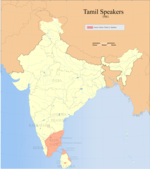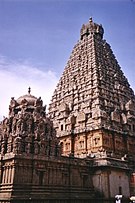Tamil inscriptions
This list is incomplete; you can help by . (January 2019) |

| Part of a series on |
| Tamils |
|---|
 |
|
|



| Part of a series on |
| History of Tamil Nadu |
|---|
 |
| Outline of South Asian history |
|---|
 |
This is a list of archaeological artefacts and epigraphs which have Tamil inscriptions. Of the approximately 100,000 inscriptions found by the Archaeological Survey of India (2005 report) in India, about 60,000 were in Tamil Nadu[1]
Ancient Tamil Epigraphy[]
- Burial of Adichanallur, Tamil Nadu found with graffiti and Tamili script[2][3][4]
- Keeladi excavation site found with Tamili inscriptions in various structures and artifacts, on pottery with Tamil names such as Aathan, Uthiran, Kuviran-Aathan and Thisan.[5][6]
6th century BCE[]
- Annaicoddai seal (steatite seal), Tamili inscriptions mixed in with Megalithic Graffiti Symbols found in Annaicoddai, Sri Lanka, c. 1000 BCE – c. 300 BCE[7][8]
5th century BCE[]
- Tamizh script dating to 500 BCE found at Porunthal site is located 12 km South West of Palani, Tamil Nadu
- Tamizh script dating to 500 BCE found at Kodumanal, Chennimalai near Erode, Tamil Nadu
- Punch-marked coins of 5th century BCE found at Karur, on the bank of river Amaravathi, is located at 78 km from Tiruchirappalli, Tamil Nadu[13]
- A terracotta weight holder with inscriptions in Tamizh has been excavated by archaeologists at a megalithic site in Periya Thadagam, on Coimbatore outskirts, Tamil Nadu, 5th – 3rd century BCE[14][15]
The Tamizh script on the black and red, four-cm-long ‘thangi’ read ‘thavan sathan’, which meant meditating hermit
4th century BCE[]
- Ancient Pottery dating back to the 4th century BCE have been discovered off shore by marine archaeologists east of Poompuhar, also known as Kaveripattinam is a town in the Nagapattinam district of Tamil Nadu. Kaveripattnam was a thriving ancient capital port city of the Early Chola Empire.[16]
3rd century BCE[]
There are five caves in the hill of which six inscriptions are found in four caves.[20] These were inscribed during Sangam period, hence it is considered as one of the important inscriptions in Tamil Nadu.[21] The inscriptions mentions that workers of Nedunchezhiyan I, a Pandyan king of Sangam period, (c. 270 BCE) made stone beds for Jain monks. It further details the name of worker for whom he made stone bed. For example, an inscription shows that Kadalan Vazhuthi, a worker of Nedunchezhiyan made stone bed to Jain monk Nanda Sirikuvan.[22] It is one of the protected monuments in Tamil Nadu by the Archaeological Survey of India.[23]
- Artifact related to Early Pandyan Kingdom's King Nedunchezhiyan I (c. 270 BCE) found in Kovalanpottal, Madurai district, Tamil Nadu[24][25]
- Potsherds with Tamizh script found in Korkai, Thoothukudi district, Tamil Nadu, 3rd century BCE[26]
- Tamizh inscription, dating back to 3rd century BCE, engraved in a cave where early Jain monks were said to have resided found in Arittapatti village, Madurai district, Tamil Nadu[27][28]
- Tamizh script dating back to the 3rd century BCE near Thenur, Madurai, Tamil Nadu. Script is written in gold bar[29]
- Black and red ware potsherd with Tamizh inscriptions in Ucchapanai, Kandarodai, Jaffna, Sri Lanka, 3rd century BCE[30][31]
2nd century BCE[]
- Black and red ware piece containing Tamizh inscription found in Mangudi, Tirunelveli District, Tamil Nadu, 2nd century BCE[32]
The inscription has been deciphered as "Kurummangala Athan yi Yanai Po"
- Tamizh inscription in Samanamalai, Madurai district, Tamil Nadu, 2nd century BCE[33]
It reads as "Peru Thorur Kunra Ko Ayam" or "Peru Tho Ur Uzhithegne Ayam" or "Peru Te Rur Kuzhiththai Ayam"
- Potsherds with Tamizh inscriptions found in Poonagari, Jaffna, Sri Lanka, 2nd century BCE[34]
- Arikamedu Excavations, as its ancient commercial link with the Romans has been established, It is one of the Silk Road sites in India, 2nd century BCE
1st century BCE[]
- Tamizh script Rock-cavern inscription in Jambai village, Tiruvannamalai District, Tamil Nadu, 1st century BCE
It reads "Satiyaputo Atiyan Nedumaan Anjji itta Paali", In (Tamil: ஸதியபுதோ அதியந் நெடுமாந் அஞ்சி ஈத்த பாழி).[35] The meaning of the epigraph may be rendered as "The abode (pali) given by (itta) Atiyan Nedumaan Anji (name), the Satyaputra (title)". Though the record is a short one in a single line, it throws valuable light on various aspects of South Indian history. The inscription clears the doubt about the identity of the Satyaputras, a dynasty of rulers, mentioned in Ashoka's inscriptions in the 3rd century BCE[36]
- A broken storage jar with inscriptions in Tamizh script in Quseir-al-Qadim, (Leukos Limen) Egypt, 1st century BCE. Two earlier Tamizh inscription discoveries at the same site, 1st century BCE.[37]
The inscribed text is